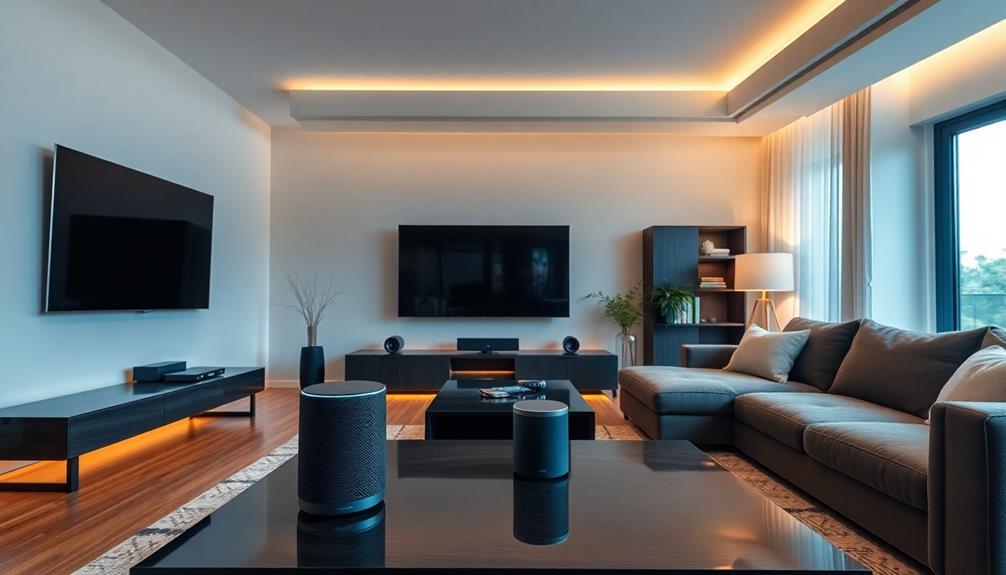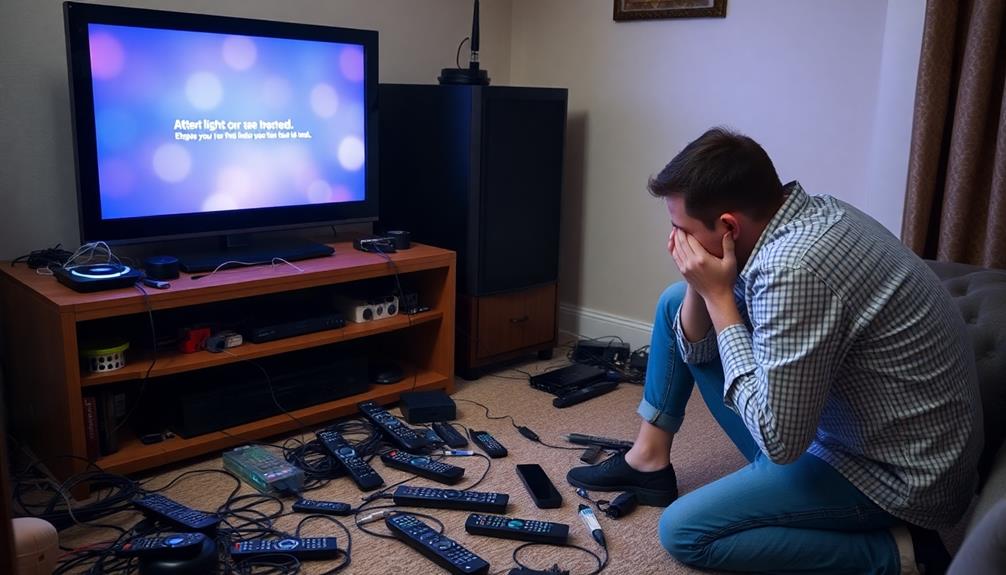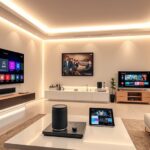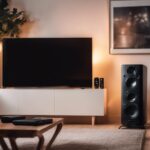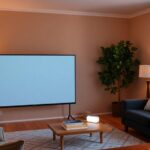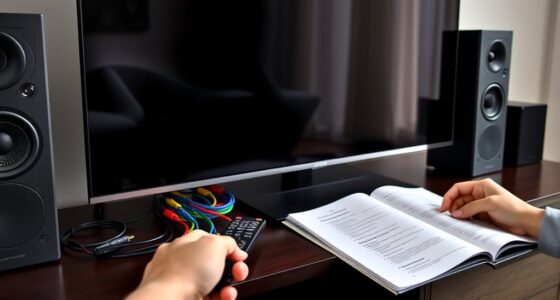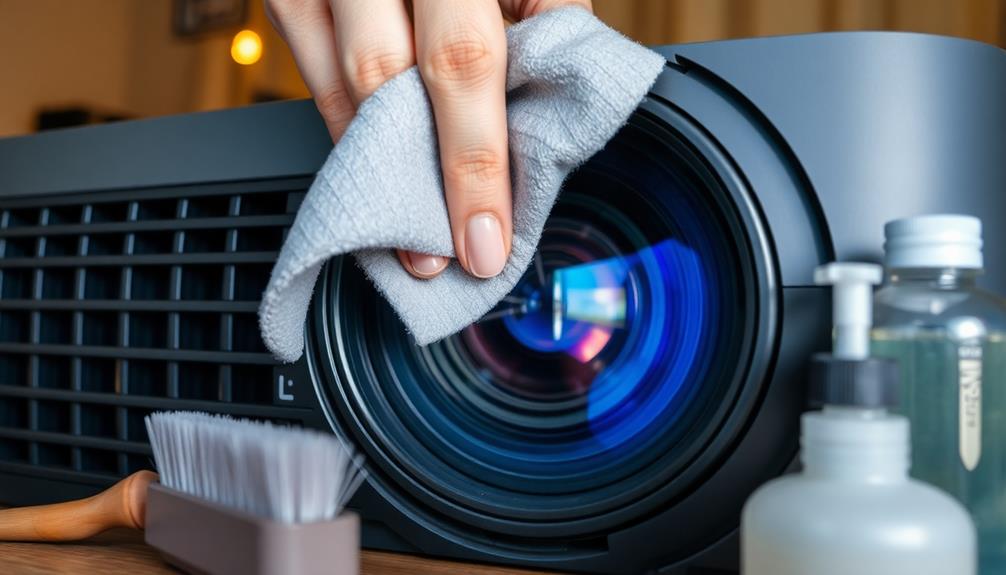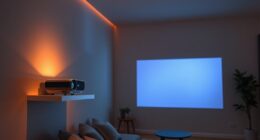Integrating voice control into your home theater system makes managing everything effortless. You can use simple commands to stream movies, adjust the volume, or change lighting without ever touching a remote. Start by selecting a compatible voice assistant, like Amazon Alexa or Google Assistant, and connecting it to your smart devices. This setup allows you to enjoy high-quality music playback from services like Spotify and TIDAL across multiple rooms. Plus, you'll enhance your overall entertainment experience while creating lasting memories. Stick around, and you'll discover tips to optimize your voice control setup even further.
Key Takeaways
- Choose a compatible voice assistant like Amazon Alexa or Google Assistant based on your existing smart devices and preferences.
- Download the respective app, connect to Wi-Fi, and ensure voice control functionality in your audio and video devices.
- Utilize compatible high-fidelity audio receivers and preamps for effective voice command management and enhanced sound quality.
- Set up multi-room audio systems to control music playback and volume across different areas of your home effortlessly.
- Regularly update software and explore additional skills to improve your voice control experience and device integration.
Benefits of Voice Control
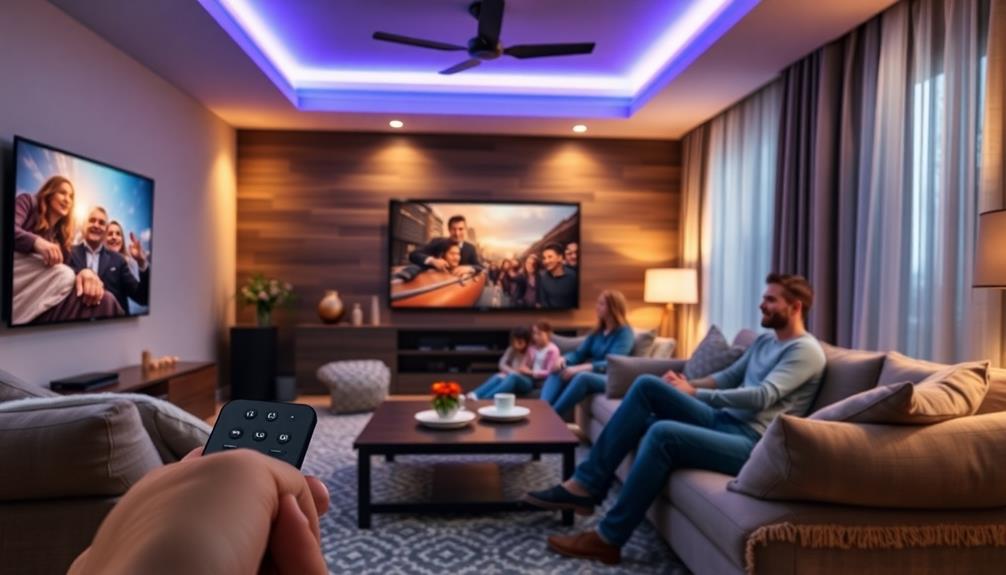
Voice control brings a new level of convenience to managing your home theater system. With just your voice, you can command your smart home devices, making it easy to adjust settings while you're cooking or entertaining guests.
Imagine streaming your favorite movie without fumbling through remotes—it's as simple as asking your voice assistant to play it. Additionally, integrating voice control with a home security system can enhance your overall smart home experience, providing added safety while you enjoy your entertainment.
These voice assistants, like Alexa and Google Assistant, support over 25,000 smart devices, ensuring compatibility across your entire home theater setup. This means you can effortlessly control everything from your TV to your sound system, enhancing your overall listening experience.
Additionally, voice control makes music playback a breeze, allowing you to switch between streaming services without lifting a finger. You can even create customized routines tailored to your viewing habits. For example, you can set a routine that dims the lights, lowers the shades, and starts your movie playlist with a single command.
As voice control technology continues to grow in popularity, with over 72% of smart speaker owners using them daily, it's clear that this hands-free approach is revolutionizing home entertainment.
Embrace the future and enjoy the benefits of voice control in your home theater.
Setting Up Voice Assistants
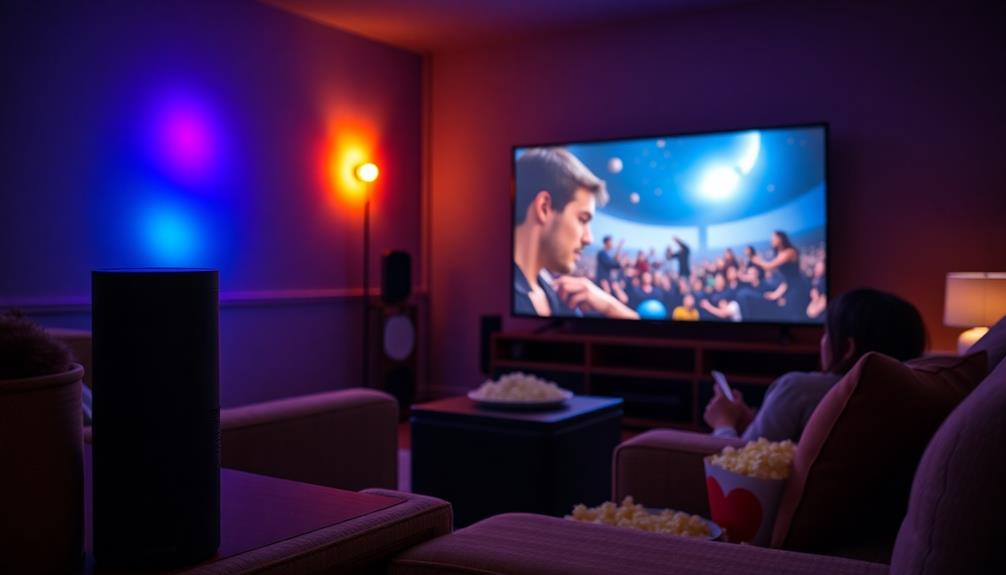
When setting up voice assistants like Amazon Alexa or Google Assistant, you'll want to choose the right one for your home theater needs.
Start the initial setup by downloading the respective app and connecting it to your Wi-Fi, ensuring compatibility with your devices.
It's important to also consider how these voice assistants can enhance your overall payment processing experience, as many users engage in online shopping via credit card insights.
This will pave the way for seamless voice control over your entertainment system.
Choosing the Right Assistant
Selecting the right voice assistant for your home theater can greatly enhance your entertainment experience.
You'll need to choose between Amazon Alexa and Google Assistant based on their compatibility with your existing smart devices. Alexa supports over 28,000 compatible devices, making it a versatile choice, while Google Assistant is deeply integrated with Nest products and supports over 25,000 devices.
Additionally, consider how your choice might work alongside other systems in your home cinema, as this could affect the role of color accuracy in your projector setup.
To get started, download the respective app for your chosen assistant—Amazon Alexa or Google Home. Connect it to your Wi-Fi and verify your audio and video devices have voice control functionality.
For the best results, opt for voice control compatible receivers and preamps, so you can manage your home theater system using voice commands, even if your devices lack built-in microphones.
If you have a multi-room setup, platforms like Sonos can help you seamlessly issue voice commands across different zones.
Don't forget to regularly check for software updates and additional skills to enhance your assistant's functionality.
Initial Setup Process
After choosing the right voice assistant, you can begin the setup process to integrate it into your home theater. Start by downloading the app for either Alexa or Google Assistant, then connect your smart speakers to your Wi-Fi network. This guarantees seamless voice control over your audio experience.
Here's what you need to do:
- Select a Compatible Receiver: Make sure your home theater system has a receiver or preamp that works with your chosen voice assistant.
- Optimize Your Setup: Download additional skills or features in the app to enhance functionality tailored to your home setup.
- Explore Multi-Room Options: Consider using platforms like Sonos to expand your voice control capabilities, allowing you to manage audio throughout your home effortlessly.
Once you've completed these steps, you'll be ready to enjoy streaming music from services like Spotify with Alexa or high-res audio via Chromecast with Google Assistant.
The initial setup process is your gateway to a more immersive home theater experience, bringing you one step closer to enjoying entertainment with just your voice!
Compatibility With Devices
Ensuring your devices are compatible is essential for setting up voice assistants like Amazon Alexa or Google Assistant in your home theater.
Start by checking if your audio and video devices, such as smart TVs and receivers, support voice control features. Both Alexa and Google Assistant require their respective mobile apps to be downloaded and connected to your home's Wi-Fi network for initial setup and device management.
Many high-fidelity audio receivers and preamps are designed to seamlessly integrate with these voice assistants, allowing you to control music playback and volume adjustments through voice commands without needing built-in microphones.
If you have a multi-room audio setup, platforms like Sonos can be easily managed via voice commands, enabling you to control different rooms with a single assistant.
Always verify device compatibility, as not all smart devices work with every voice assistant. Some may require specific skills or integrations to function properly.
By ensuring compatibility, you'll enhance your home theater experience, making it easier to enjoy your favorite movies and music with just your voice.
Embrace the convenience of voice control and transform your home theater into a smart, interactive space.
Music Playback With Voice Commands
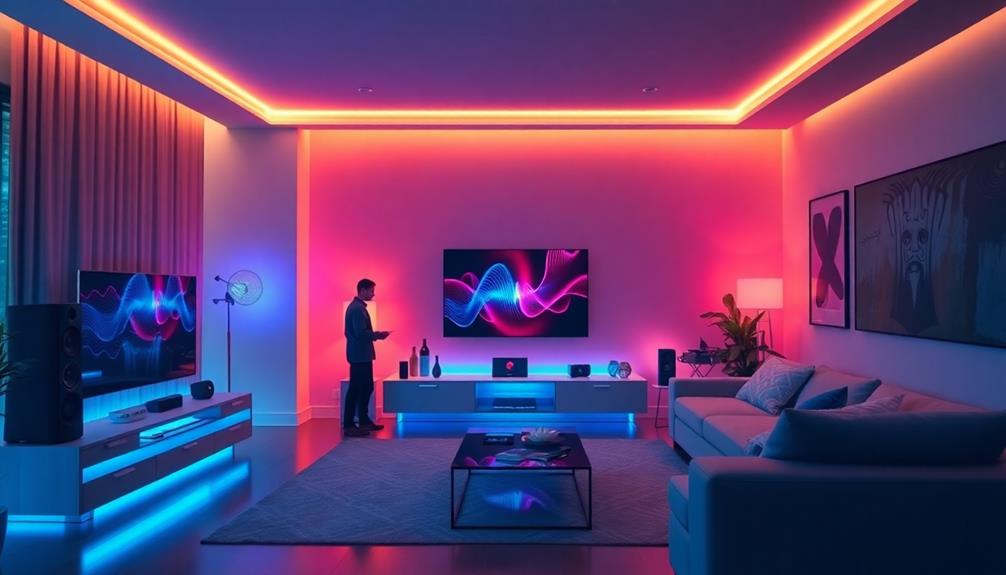
Voice control has transformed music playback into a hands-free experience, letting you easily enjoy your favorite tunes with just a simple command. With voice commands, you can stream music from platforms like Spotify and TIDAL using Alexa or Google Assistant.
Imagine the freedom of saying:
- "Play my favorite playlist," and instantly having your music fill the room.
- "Pause the music," allowing you to focus on a conversation or take a break.
- "Play music in the living room," setting the perfect mood for any gathering.
Alexa can even control compatible receivers and preamps, letting you manage music playback on traditional stereo systems without built-in microphones.
Meanwhile, Google Assistant enhances your experience with high-resolution streaming through Chromecast, ensuring every note sounds amazing. Both assistants make it easy to create multi-room audio setups, so you can enjoy seamless music playback throughout your home.
Clear and specific commands like "Skip to the next song" improve your assistant's responsiveness, making your music experience even smoother. Embrace the power of voice control and elevate your home theater with effortless music playback!
Enhancing User Experience
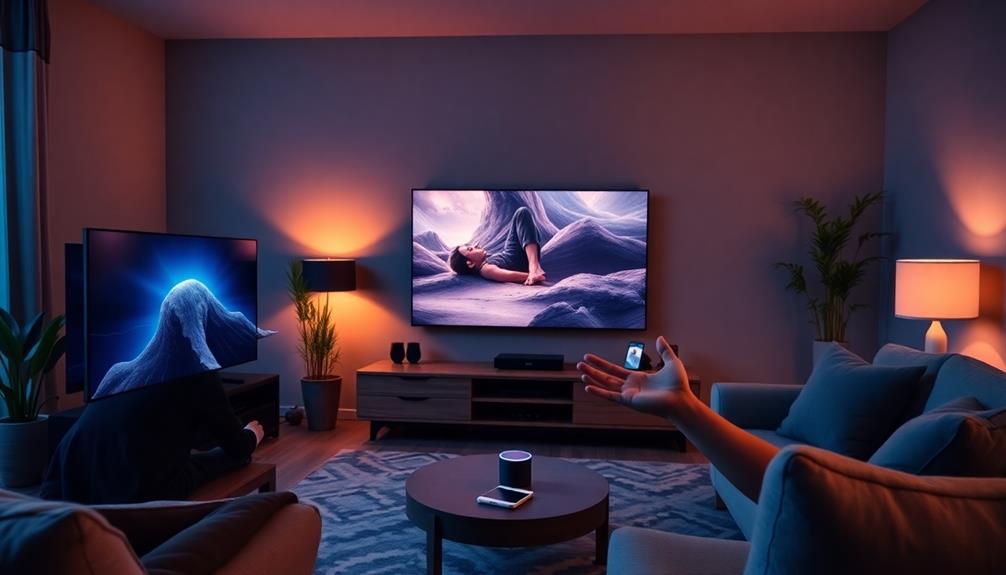
When you integrate voice control into your home theater, you'll find that music playback becomes effortless and streamlined.
With hands-free device control, you can easily manage your viewing environment without fumbling for remotes.
Plus, seamless multi-room integration guarantees you enjoy a consistent audio experience throughout your home, making every movie night unforgettable.
Streamlined Music Playback
Imagine hosting a dinner party and effortlessly controlling your music with just your voice. With voice control integrated into your home theater system, you can transform your audio experience while multitasking.
Whether you're cooking or entertaining guests, it's as simple as speaking a command.
Here are three ways voice control enhances your music playback:
- Effortless Streaming: Connect your home assistant to platforms like Spotify or TIDAL, giving you instant access to a vast music library.
- Multi-Room Music: Use voice commands to play different tracks in various rooms or synchronize them throughout your home, creating the perfect ambiance.
- High-Quality Sound: With compatible high-fidelity audio gear, your voice-controlled music maintains excellent sound quality, immersing you and your guests in the experience.
Imagine saying, "Play my dinner playlist" or "Shuffle my favorites," and watching your smart lights adjust to the mood as the music fills the room.
Streamlined music playback not only elevates your gatherings but also makes every moment enjoyable, allowing you to focus on what really matters—creating lasting memories.
Hands-Free Device Control
Hands-free device control revolutionizes your home theater experience by letting you manage everything with simple voice commands. With voice control, you can effortlessly tell your system to "Turn on the TV" or "Play my favorite movie" without having to get up. This level of convenience is especially useful when you're multitasking, whether you're cooking, cleaning, or just relaxing on the couch.
Integrating popular voice assistants like Google Assistant or Amazon Alexa makes your home control even smarter, streamlining the management of all your devices, from sound systems to lighting. Many high-fidelity audio systems and smart TVs are compatible smart options, ensuring you enjoy exceptional quality while using hands-free commands.
You can also control multi-room audio setups, allowing for a seamless listening experience throughout your home. Imagine adjusting the volume in one room while the movie plays in another, all with just your voice.
This hands-free device control not only enhances your entertainment experience but also simplifies your life, eliminating the need for multiple remotes or manual adjustments. Embrace this technology, and enjoy the effortless management of your home theater system.
Seamless Multi-Room Integration
Seamless multi-room integration takes the convenience of voice control to another level, allowing you to enjoy a synchronized audio experience throughout your home. With platforms like Sonos, you can manage audio playback effortlessly using voice commands.
Imagine the ease of controlling your music across different rooms with just your voice.
Here are a few advantages of multi-room integration:
- Unified Listening: Enjoy your favorite playlists in every room, creating a consistent atmosphere.
- Custom Control: Adjust volume individually or group speakers together—just say, "Play music in the living room" or "Turn down the volume in the kitchen."
- Smart Automation: Integrate smart switches, like the Brilliant smart switch, to control lighting and audio seamlessly.
With Amazon Alexa and Google Assistant, you can easily create customized playlists and schedules tailored to each space.
This level of multi-room integration elevates your home theater experience, turning your living space into a truly connected environment.
You can set the mood for movie nights, dinner parties, or casual gatherings with just a few spoken words, making your home not just smarter, but also more enjoyable.
Privacy Considerations

When integrating voice control into your home theater, it's vital to reflect on the privacy implications that come with these devices. Voice control systems, like Amazon Alexa and Google Assistant, are designed to listen for voice commands continuously, which raises significant privacy concerns. Unauthorized data collection can occur if these systems aren't managed properly.
To secure your home, you can disable voice assistants or use physical mute buttons—like the one on the Google Nest Mini—to limit their listening capabilities. Regularly adjusting app settings allows you to manage privacy features effectively. For instance, turning off the voice assistant when you're not using it can minimize data exposure.
Advanced speech recognition systems, such as Josh.ai, prioritize privacy by processing voice commands locally. This approach reduces reliance on cloud storage, enhancing security.
It's also important to stay informed about the privacy policies of your voice assistant devices. Regularly reviewing settings guarantees your personal information is adequately protected.
Recommended Products and Resources
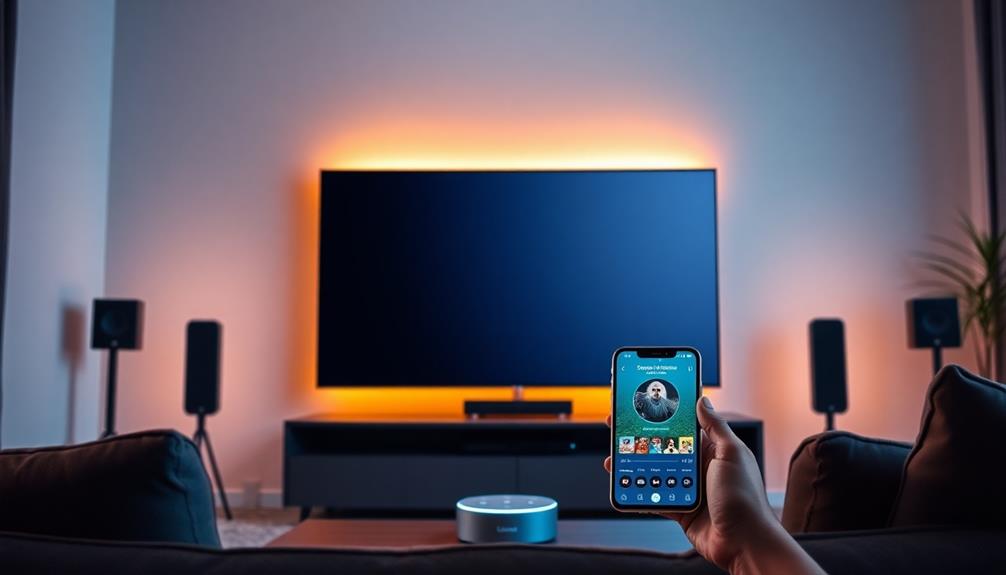
Creating an immersive home theater experience becomes easier with the right voice control products.
You'll want to take into account options that not only deliver exceptional sound but also integrate seamlessly into your setup.
Here are three must-have products to elevate your home theater:
- Sonos One – Priced at around $199, this speaker offers high-fidelity audio and works effortlessly with both Amazon Alexa and Google Assistant, allowing you to control your entertainment with ease.
- Google Nest Audio – At $99.99, this speaker provides robust sound quality and voice control, making it a fantastic addition for enhancing your viewing experience.
- Amazon Echo Dot (4th Gen) – Starting at just $49.99, this affordable option serves as a perfect entry point for managing your home theater and streaming music through voice commands.
To guarantee you select the best voice control compatible products, utilize the SpeakerCompare tool.
Following these best practices will help you create a cohesive smart home environment that complements your home theater, making every movie night unforgettable!
Frequently Asked Questions
Can I Connect Alexa to My Home Theater?
Yes, you can connect Alexa to your home theater. Use a compatible smart receiver or soundbar, download the Amazon Alexa app, and follow the setup instructions to enable voice control for your audio playback.
Can I Connect Alexa to My Receiver?
Absolutely, you can connect Alexa to your receiver! Just verify it's compatible, connect to Wi-Fi, and enable the skill in the Alexa app. Then you'll control playback and volume effortlessly with your voice.
Can I Connect Alexa to My Amp?
Yes, you can connect Alexa to your amp! Just use a compatible receiver or connect an Echo device via auxiliary input. Make certain both are on the same Wi-Fi network, and enjoy voice-controlled audio playback!
What Is a Home Voice Controller?
A home voice controller's a smart device that lets you control your entertainment systems hands-free. You can use simple voice commands to manage devices like TVs, speakers, and streaming services, enhancing your overall experience.
Conclusion
Incorporating voice control into your home theater system not only simplifies your entertainment experience but also enhances your lifestyle. Did you know that 55% of households now use smart speakers, indicating a significant shift towards voice-driven technology? By leveraging voice commands, you can easily manage playback, adjust settings, and create an immersive atmosphere with just your voice. Embrace this technology to elevate your home theater experience while enjoying the convenience it brings to your daily routine.
Hello, I’m Art, and I’m excited to be a part of the 1Home Theatre Projector team. As a writer, I’m here to contribute my knowledge and insights to help you achieve the ultimate home cinema experience. I understand that making decisions in the world of home entertainment can be complex, and I’m here to simplify the process for you.
